Taxonomy: Class: Mammalia; Order: Artiodactyla; Family: Cervidae
Description
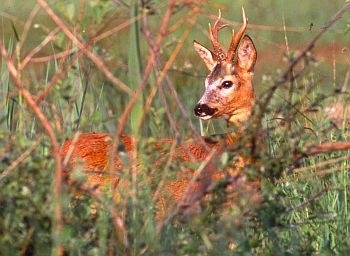
Roe deer © Alexis de la Serre
The roe deer is the smallest native British deer. Its coat varies from dark grey-brown in winter to reddish in summer, but always shows a cream rump patch and insignificant tail. The antlers of the male are small. It was close to extinction some 300 years ago and still localised a century ago. Helped by re-introductions, it has steadily expanded its range since the 1960s. It is considered a pest in some areas because of damage to agriculture and forestry. Bucks may be shot from 1 April to 31 October, does from 1 November to 31 March.
Further information:
Mammal Society website roe deer page.
Conservation status and legislation
Status:
UK: Native
World: Least Concern (IUCN Red List)
Legislation:
Distribution and abundance
The roe deer is the most widely distributed deer species in the UK. It is found across mainland Scotland, northern England, most of East Anglia, most of southern England and is starting to colonise Wales. It is absent from the Isle of Wight and most Scottish islands except Arran, Bute, Islay, Seil and Skye. It is also missing from Ireland.
Estimates of roe deer abundance (numbers of individuals in the spring) across the UK, from Harris et al. (1995):
Recent trends from the National Gamebag Census
United Kingdom
Index of bag density from 1961 to 2009 (see statistical methods and interpretational considerations).
Error bars represent 95% confidence intervals.
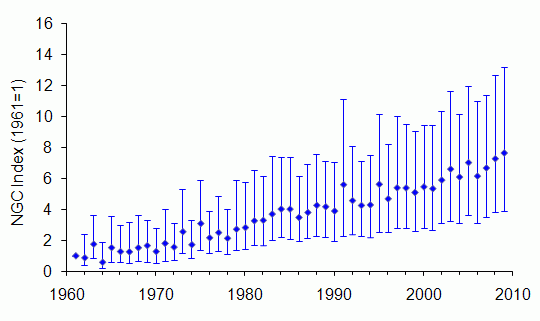
There has been a significant and sustained increase in the bag index between 1961 and 2009. This corresponds to a spectacular period of range expansion and increasing abundance (see maps) following near extinction and subsequent re-introductions. The increase in bag index may also reflect greater effort from stalking.
Change in roe deer bags over time, with 95% confidence limits (see statistical methods):
| Country |
Sites |
Start
year |
End
year |
Change (%)
1961-2009 |
Change (%)
1984-2009 |
Change (%)
1995-2009 |
| United Kingdom |
570 |
1961 |
2009 |
660*
320 to 1297 |
104*
70 to 142 |
49*
32 to 69 |
* significant at P < 0.05
England
Index of bag density from 1970 to 2009 (see statistical methods and interpretational considerations).
Error bars represent 95% confidence intervals.
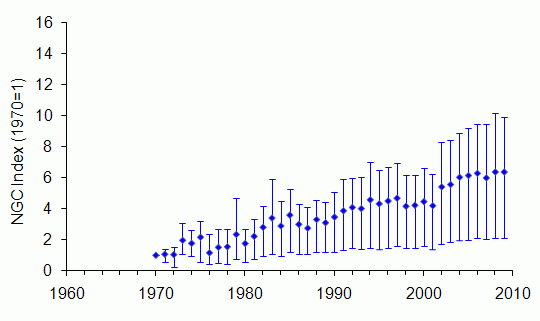
There has been a significant and sustained increase in the bag index between 1970 and 2009. This corresponds to a spectacular period of range expansion and increasing abundance (see maps) following near extinction and subsequent re-introductions. The increase in bag index may also reflect greater effort from stalking.
Change in roe deer bags over time, with 95% confidence limits (see statistical methods):
| Country |
Sites |
Start
year |
End
year |
Change (%)
1961-2009 |
Change (%)
1984-2009 |
Change (%)
1995-2009 |
| England |
297 |
1970 |
2009 |
339*
236 to 649 |
127*
74 to 196 |
54*
29 to 90 |
* significant at P < 0.05
Scotland
Index of bag density from 1961 to 2009 (see statistical methods and interpretational considerations).
Error bars represent 95% confidence intervals.
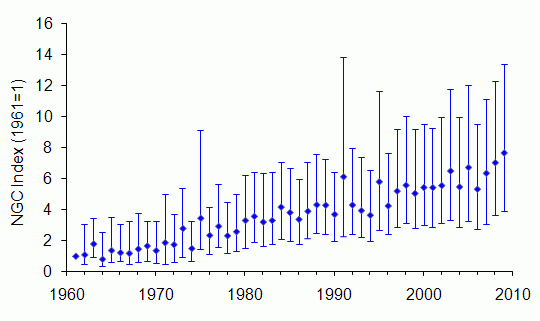
There has been a significant and sustained increase in the bag index between 1961 and 2009. This corresponds to a spectacular period of range expansion and increasing abundance (see maps) following near extinction and subsequent re-introductions. The increase in bag index may also reflect greater effort from stalking.
Change in roe deer bags over time, with 95% confidence limits (see statistical methods):
| Country |
Sites |
Start
year |
End
year |
Change (%)
1961-2009 |
Change (%)
1984-2009 |
Change (%)
1995-2009 |
| Scotland |
268 |
1961 |
2009 |
596*
220 to 1109 |
94*
53 to 140 |
47*
22 to 79 |
* significant at P < 0.05
Wales
There are too few bag records of roe deer to produce an index graph. 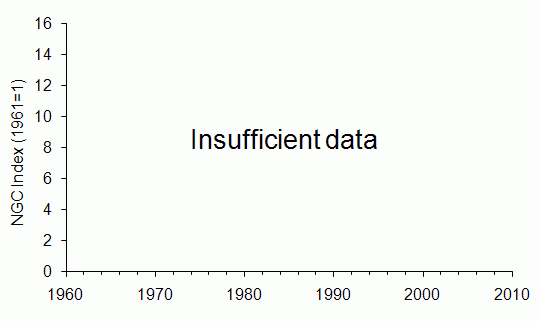
Two sites in Wales, both close to the border with England, have reported roe deer bags in recent years. This refects the continuing westwards spread of the species (see maps).
There are too few bag records of roe deer to evaluate rates of change over time
| Country |
Sites |
Start
year |
End
year |
Change (%)
1961-2009 |
Change (%)
1984-2009 |
Change (%)
1995-2009 |
| Wales |
Too few sites |
N Ireland
There are too few bag records of roe deer to produce an index graph. 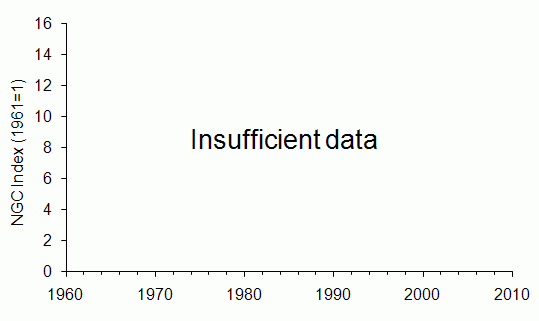
There are too few bag records of roe deer to evaluate rates of change over time
| Country |
Sites |
Start
year |
End
year |
Change (%)
1961-2009 |
Change (%)
1984-2009 |
Change (%)
1995-2009 |
| N Ireland |
Too few sites |
Environmental zones
Change in roe deer bags over time, with 95% confidence limits (see statistical methods):
| Environmental zone |
Sites |
Start
year |
End
year |
Change (%)
1961-2009 |
Change (%)
1984-2009 |
Change (%)
1995-2009 |
| Easterly lowlands (England/Wales) |
192 |
1977 |
2009 |
330*
159 to 703 |
111*
51 to 203 |
49*
25 to 86 |
| Westerly lowlands (England/Wales) |
64 |
1977 |
2009 |
205*
77 to 637 |
111*
55 to 208 |
31
-8 to 98 |
| Uplands (England/Wales) |
37 |
1984 |
2009 |
no data |
194*
44 to 998 |
170*
79 to 243 |
| Lowlands (Scotland) |
72 |
1977 |
2009 |
123*
65 to 258 |
109*
63 to 194 |
59*
12 to 120 |
| Intermediate uplands/islands (Scotland) |
39 |
1977 |
2009 |
396
-4074 to 4228 |
22
-17 to 64 |
15
-16 to 57 |
| True uplands (Scotland) |
155 |
1961 |
2009 |
430*
122 to 753 |
102*
34 to 176 |
38*
5 to 83 |
* significant at P < 0.05
Comparison with BBS mammal data
Since 1995, data on roe deer abundance have been collected under the Breeding Bird Survey (BBS) organised by the British Trust for Ornithology. Below, the UK trend from the NGC is compared to the one from the BBS (from 1995 onwards).
NGC index of bag density (blue) and BBS index of abundance (red), from 1995 to 2009.
Error bars represent 95% confidence intervals.
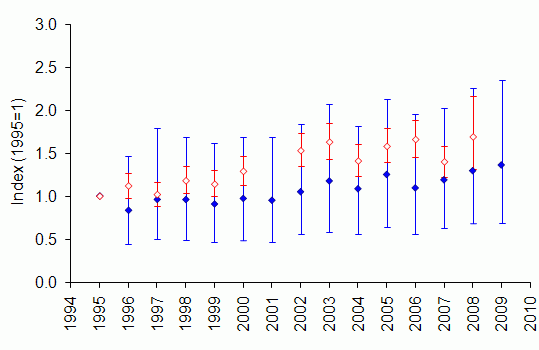
Both sets of indices show significant increases since 1995. For all years, the BTO confidence intervals are completely or almost completely within the NGC confidence intervals, indicating good agreement between the two index series.
Long-term trend from the National Gamebag Census
Index of bag density from 1901 to 2009 (see statistical methods and interpretational considerations).
Error bars represent 95% confidence intervals.
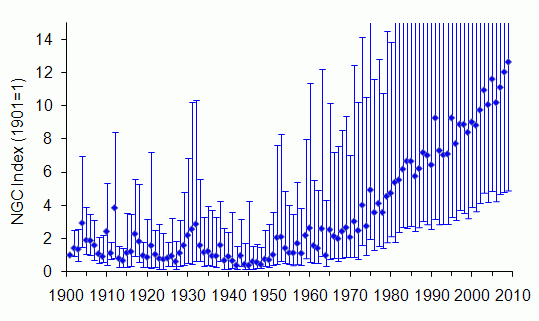
The bag index remained fairly stable between 1901 and 1960, but there has been a significant and sustained increase from the 1960s to the present day. The period of increase reflects the ongoing range expansion and increasing abundance of the species (see maps) following near extinction and subsequent re-introductions. Why the increase began when it did was probably linked to a combination of habitat expansion (through new forestry plantings) and changes in the law (control by snaring and shotgun drives was outlawed). This led to an greater use of stalking, first for control, then as a source of income.
References and further reading
- Battersby,J. (2005). UK Mammals: Species Status and Population Trends. Joint Nature Conservation Committee/Tracking Mammals Partnership, Peterborough (JNCC download page).
- Deer Initiative (2008). Species Ecology: Roe Deer. England & Wales Best Practice Guides, The Deer Initiative, Chirk (PDF file - 4,830 KB).
- Fawcett,J.K. (1997). Roe Deer. Mammal Society & British Deer Society, London & Fordingbridge.
- Harris,S., Morris,P., Wray,S. & Yalden,D.W. (1995). A Review of British Mammals: Population Estimates and Conservation Status of British Mammals Other than Cetaceans. Joint Nature Conservation Committee, Peterborough (JNCC download page).
- Harris,S. & Yalden,D.W. (2008). Mammals of the British Isles: Handbook, 4th edition. Mammal Society, Southampton.
This report should be cited as: Aebischer,N.J., Davey,P.D. & Kingdon,N.G. (2011). National Gamebag Census: Mammal Trends to 2009. Game & Wildlife Conservation Trust, Fordingbridge (http://www.gwct.org.uk/ngcmammals).
Return to species list